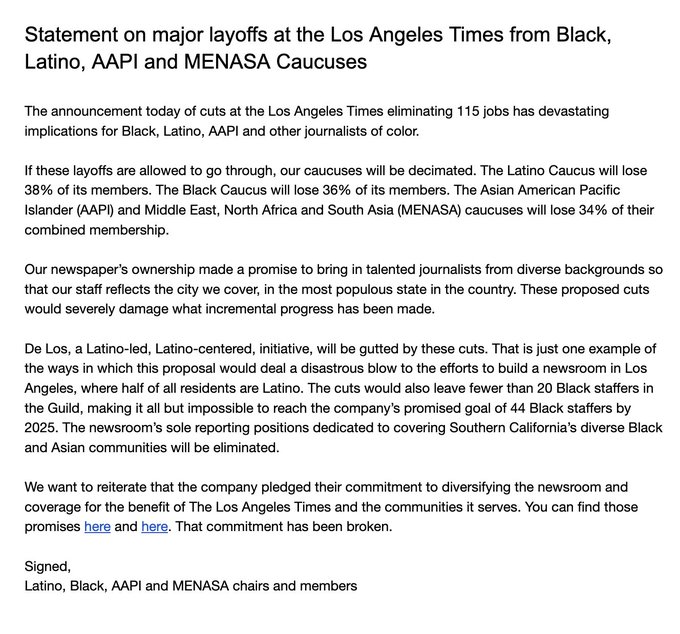Homepage photo: Statement on major layoffs at the Los Angeles Times from Black, Latino, AAPI and MENASA Caucuses

Layoffs to Affect More Than 20 Percent of Newsroom
The Los Angeles Times announced Tuesday that it was laying off at least 115 people — or more than 20 percent of the newsroom, with the ax disproportionately falling on young journalists of color, according to the Los Angeles Times Guild.
 “If these layoffs are allowed to go through, our caucuses will be decimated,” Brian Contreras (pictured), chair of the L.A. Times Guild Unit Council, messaged Journal-isms.
“If these layoffs are allowed to go through, our caucuses will be decimated,” Brian Contreras (pictured), chair of the L.A. Times Guild Unit Council, messaged Journal-isms.
“The Latino Caucus will lose 38% of its members. The Black Caucus will lose 33% members. The AAPI [Asian American Pacific Islander] and MENASA [Middle East, North Africa, South Asia] caucuses will lose 34% of their combined membership.
“This is in large part because the company refused to offer newsroom-wide voluntary buyouts before launching these layoffs, which could’ve incentivized more senior staff members (who are disproportionately white) to step up and take the place of younger staff members (who are disproportionately POCs and more likely to get laid off). During our summer layoffs, buyouts went a long way toward reducing the racial impact of the cuts.”
Contreras, a technology reporter who is half-Cuban and a member of the Latino Caucus, is himself on the layoff list.
But Contreras told Journal-isms he does not believe his layoff was related to his Guild position. “Under our contract, the company has to follow (with a few exceptions) a last in, first out layoff model. I was hired fairly recently, in 2020, so I was subject to that rule.”
 Times Managing Editor Sara Yasin (pictured), one of the nation’s highest-ranking Palestinian American journalists, “resigned Monday amid the turmoil gripping the newsroom in advance of deep staff cuts that are looming,” Meg James reported for the Times.
Times Managing Editor Sara Yasin (pictured), one of the nation’s highest-ranking Palestinian American journalists, “resigned Monday amid the turmoil gripping the newsroom in advance of deep staff cuts that are looming,” Meg James reported for the Times.
“Yasin’s departure comes a little more than a week after Executive Editor Kevin Merida abruptly left, citing differences with the paper’s owner, Dr. Patrick Soon-Shiong. The owner has ordered extensive staff cuts to trim the tens of millions of dollars in losses that he and his family have absorbed since buying The Times nearly six years ago.
 “Another top editor, Shani Hilton (pictured), stepped down last week, bringing to three the number of top editors who have exited during a stormy period at The Times. Merida and Hilton were The Times’ two highest-ranking Black editors.”
“Another top editor, Shani Hilton (pictured), stepped down last week, bringing to three the number of top editors who have exited during a stormy period at The Times. Merida and Hilton were The Times’ two highest-ranking Black editors.”
 Lois Beckett added for the Guardian, “Among the journalists laid off on Wednesday were the paper’s Pulitzer Prize-winning DC Bureau Chief, Kimbriell Kelly (pictured) and its deputy DC bureau chief, Nick Baumann, who received their layoff notices on Tuesday, the day of the New Hampshire presidential primary election.
Lois Beckett added for the Guardian, “Among the journalists laid off on Wednesday were the paper’s Pulitzer Prize-winning DC Bureau Chief, Kimbriell Kelly (pictured) and its deputy DC bureau chief, Nick Baumann, who received their layoff notices on Tuesday, the day of the New Hampshire presidential primary election.
“Among the journalists laid off was one of the paper’s only Indigenous editors, and many of those working on the paper’s newly launched De Los section, designed by and for Latinos, who make up roughly half of Los Angeles county’s population, and who have been historically underrepresented among the paper’s staff.”
Kelly announced on X, “I was laid off today. Winning a Pulitzer was one honor of my life. Another, leading the Washington Bureau as its first person of color and only second woman.“
 Angie Jaime (pictured), an Indigenous editor, posted, “Know this — this is not the last you’ll hear from me.”
Angie Jaime (pictured), an Indigenous editor, posted, “Know this — this is not the last you’ll hear from me.”
Columnist Jean Guerrero wrote on the same platform, “I’ve been laid off from my job as a columnist for the LA Times today, with 100 of my best colleagues. It’s a dark day. I was the only Latina columnist for the opinion desk. Trump is looming & I’m author of Hatemonger. If you’re hiring, I’m at jeangue619 (at) gmail.com.”
Wrote Jeong Park, “I’ll have more reflection once this wears off, but hey, how many people can say they’ve worked their dream job before turning 30? I can say that. I have no regrets — But hopes the LA Times can keep the beat of covering Asian American communities which remain vital to SoCal.”
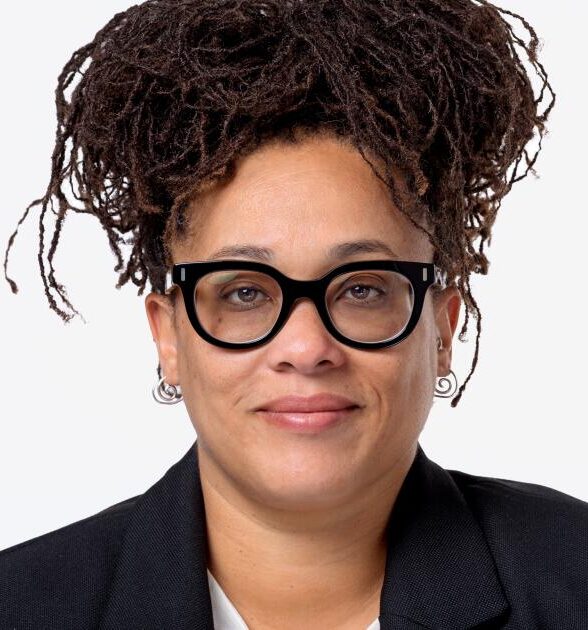 Erika D. Smith (pictured), a columnist at the paper and co-chair of the guild’s Black Caucus, said there was a lot of “shock right now and a lot of sadness” among the staff, Yusra Farzan reported for LAist.
Erika D. Smith (pictured), a columnist at the paper and co-chair of the guild’s Black Caucus, said there was a lot of “shock right now and a lot of sadness” among the staff, Yusra Farzan reported for LAist.
“ ‘There’s about a dozen journalists, Black journalists who were affected by the layoffs, it really decimated the number of Black people we have on the masthead at the LA Times,’ she said.
“Smith said when Patrick Soon-Shiong bought the paper in 2018 there was a push to diversify the newsroom to better reflect Southern California’s population.
“I think we had a pretty substantial diverse staff, definitely one of the most diverse newsrooms I’ve ever worked in, personally,” Smith told LAist. “I think [the cutback is] going to affect coverage in a way that we don’t really know what that’s going to look like obviously when it comes to covering Latino communities, AAPI, Black communities.”
Smith told Journal-isms, “of the 30 Black members of the Guild, 11 were laid off. “
James wrote in the Times, “The L.A. Times historically has struggled to diversify its staff to better reflect such a diverse region as California. A round of layoffs in the summer, which included dozens of journalists of color, was a setback to those efforts. The newsroom was cut by 13% then.
“Hilton, who’d been at the paper for four years, told staff members last week that she had been planning to leave even before Merida’s departure. She oversaw L.A. Times Studios, which was hard hit by a round of layoffs in December.”
The Guardian account continued, “The journalists’ union blamed ‘years of middling strategy, the absence of a publisher, and no clear direction’ for the layoffs, and wrote: ‘It is still unclear who is in charge of our newsroom more than a week after our executive editor resigned.’
“While saying that they ‘remain grateful for the Soon-Shiong family’s investment in the newspaper’, the journalists also wrote: ‘It’s clear that those entrusted to steward his family’s largesse have failed him – not the rank-and-file staff members with no say in editorial priorities.’ “
“Ten Democratic members of Congress sent a letter to Soon-Shiong and Media Guild of the West President Matt Pearce, imploring the two sides to find less devastating ways to handle the staff cuts that could see the largest newsroom in the western U.S. shrink by more than 20%. The letter comes after a one-day strike on Friday by the newsroom union,” James reported.
- Oliver Darcy, CNN: The Los Angeles Times plunges into ‘chaos’ as brutal layoffs loom and senior editors call it quits
- Rafu Shimpo, Los Angeles: AAJA-LA Supports Times’ Newsroom Union
The Many Ways the U.S. Has Been Racist
Jan. 21, 2024
Washington Post Analysis Responds to Nikki Haley
Thumbs Up, Thumbs Down on Press Freedom Issues
SI Vows to Continue, Despite Layoffs
In L.A. Times Walkout, Some Lose Email Access
N.Y. Post ‘Sources’ Find CBS News Leader Too ‘Woke’
Baltimore Sun Sale Greeted With Hostility
Israel Holding 31 Palestinian Journalists
Gary Fife, Indigenous Mentor, Role Model, Dies at 73
Short Takes: Robert Samuels; $100 million gift to Spelman; Tiffany Cross; Univision cuts; new high for Black population; remedying men’s lack of close friends; attempts to co-opt Black civil rights leaders, news media; Sarasota Herald-Tribune investigation; new figures on police killings of Blacks; identifying diverse content creators; Morgan State U. and Spike Lee’s 40 Acres & A Mule Filmworks;
Alice Dunnigan, Ethel Payne and today’s White House; new Spanish news segment in Kansas City; making AM radio mandatory in cars; Cleveland Plain Dealer and protection of Native artifacts; Rochester’s Carolyne Blount; oral history project for Indigenous who attended boarding schools; lack of progress in Cameroon journalist’s murder; abuse of journalists in Somalia; Grenada bars reporters; commentator’s arrest in Burundi.
Support Journal-isms
Washington Post Analysis Responds to Nikki Haley
“A Republican presidential primary campaign that has often focused on issues of race — Donald Trump’s ‘poisoning the blood’ rhetoric, Ron DeSantis’s slavery curriculum in Florida and Nikki Haley’s initial failure to cite slavery as the cause of the Civil War — has now turned to this question: The lingering effects of systemic racism aside, has the country ever been racist?” Aaron Blake wrote Thursday for The Washington Post, before DeSantis dropped out of the race.
“As The Washington Post’s Mariana Alfaro and Maegan Vazquez report, Haley is doubling down on her claim that it has not. Haley has said for years that this isn’t a racist country, but she has extended that claim to cover 250 years of U.S. history.
“ ‘America has always had racism, but America has never been a racist country,’ Haley’s campaign said in a statement Wednesday night.
“Many people, including The Post’s Philip Bump, have unpacked the ways in which racism is ingrained in America’s past — and often in its official policies.
“What Haley’s updated statement seems to suggest is an attempt to separate racism that has clearly existed in the United States from the country’s underlying character.
“But as we digest that, it’s important to understand just how pervasive racist beliefs have been in the relatively recent past. A country, after all, is made up of its people, however much President Biden likes to say that ‘America is an idea.’
“For that, we have polling dating back to the 1930s that provides insights, courtesy of the Roper Center’s great archive. Those polled at the time were disproportionately educated, White and male, but that also means the polling reflects how the most powerful demographic groups in the country felt. And depending on the question posed, a plurality or even a majority expressed racist views.
“What may be the oldest, extensive, detailed data we have on this topic comes from the National Opinion Research Center (NORC) in the 1940s. It found:
- “47 percent of Americans said restaurants shouldn’t serve both White and Black customers (surveys back then generally used the word “negro” instead of “Black”).
- “46 percent wouldn’t like being treated by a Black nurse.
- “51 percent said White people should get the first shot at a job over a Black person.
“Some other key findings around this period:
- “63 percent said White and Black troops should be separated (Gallup, 1948).
- “A majority supported school segregation in the South (Life magazine, 1950).
- “71 percent said Black people were less intelligent, and nearly half both agreed with that and said it was because they were born that way (Fortune magazine, 1939).
- “While 94 percent disapproved of how the Nazis treated Jewish people, nearly two-thirds said the persecution of Jews in Europe was entirely (11 percent) or partly (54 percent) the Jewish people’s own fault (Gallup, 1938).
- “Just 39 percent said Jewish people should be treated the same as all Americans; the rest preferred statements cautioning against Jews intermingling with others (11 percent), wanting to prevent Jews from gaining too much power in the business world (32 percent), or wanting to deport them to a ‘new homeland’ (10 percent) (Fortune, 1939).
- “Americans were about evenly split on whether Jewish people ‘have too much power and influence in this country’ (Office of Public Opinion Research, 1942).”
Blake went on to cite figures from the 1960s and continued, “This is an incomplete picture, in large part because we don’t have good data on where Americans stood for about two-thirds of our nation’s history. Given the trends and how the country treated Black people, in particular, racism almost surely was significantly more pervasive in the 1800s.
“But we’re also talking about findings that aren’t too far in our nation’s past; about half of the numbers you see above reflect the country as it existed when both of our likely 2024 major-party presidential nominees were alive.”
- Jenice Armstrong, Philadelphia Inquirer: Donald Trump demonized Yusef Salaam as a child. So why has Salaam forgiven him?
- AsAmNews: Nikki Haley criticized for not connecting to Indian Americans (Jan. 11)
- Payton Armstrong and Ethan Collier, Media Matters for America: Right-wing media spend Martin Luther King Jr. Day launching attacks on the civil rights icon
- Wayne Bennett, Field Negro: Nikki and the S word. (Dec. 31)
- Nicholas Confessore, New York Times: ‘America Is Under Attack’: Inside the Anti-D.E.I. Crusade
- Jason Dearen, Associated Press: Book Review: Scholars analyze extremist white supremacy’s grip on U.S. politics and culture
- Roy S. Johnson, al.com: Why (some) whites don’t see diversity, equity, and inclusion includes them
- Julian Mark, Washington Post: When Reagan tried to undo affirmative action, corporations fought back
- Kara Nelson, CNN: How clashing interpretations of Martin Luther King’s legacy fuels the fight over DEI and affirmative action
- Michele Norris, Washington Post: Our true feelings about race and identity are revealed in six words
- Clarence Page, Chicago Tribune: Donald Trump, unifier? That’s a new one
- Sara Pequeño, USA Today: Haley says America has never been ‘racist.’ Her own family history says otherwise.”>never been ‘racist.’ Her own family history says otherwise.
- Eugene Robinson, Washington Post: Ron DeSantis and Nikki Haley have lost their way
- Erika D. Smith, Los Angeles Times: In flub over Civil War, Nikki Haley reveals a surprising truth about the culture wars (Dec. 28)
- Amy B Wang, Maegan Vazquez and Azi Paybarah, Washington Post: Trump lobs racially charged attacks against Haley ahead of N.H. primary
- Armstrong Williams, Creators Syndicate: Charlie Kirk’s Dastardly Attack on Nobel Prize Winner Dr. Martin Luther King Jr.

“Tonight our message is this: journalism is not a crime. Evan and Austin should be released immediately, along with every American held hostage or wrongfully detained abroad,” President Biden said in May. Russia’s Federal Security Service detained Evan Gershkovich on March 29, 2022, while he was on a reporting assignment. Austin Tice, freelance journalist, was kidnapped while reporting in Syria on Aug. 14, 2012. (Credit: incontexmedia/X)
Thumbs Up, Thumbs Down on Press Freedom Issues
“With more than half the world’s population set to go to the polls in 2024, the next U.S. presidential election bears greater significance than ever before, both for the domestic press freedom climate, and for the example that the country of the First Amendment will set for the world,” Reporters Without Borders said Tuesday.
The Paris-based organization took the opportunity “to examine the records and statements on press freedom of the leading presidential candidates:
“Donald Trump
 “The former president and leading Republican candidate has a mostly acrimonious attitude towards the news media. In 2017, Trump famously called the media ‘the enemy of the people.’ During Trump’s time in office, the U.S. saw a decline in its rating on the World Press Freedom Index, and a record number of journalists were arrested. He refused to hold regular press conferences and berated journalists throughout his term. During the January 6, 2021, Capitol riot, Trump’s supporters attacked and threatened reporters. . . .
“The former president and leading Republican candidate has a mostly acrimonious attitude towards the news media. In 2017, Trump famously called the media ‘the enemy of the people.’ During Trump’s time in office, the U.S. saw a decline in its rating on the World Press Freedom Index, and a record number of journalists were arrested. He refused to hold regular press conferences and berated journalists throughout his term. During the January 6, 2021, Capitol riot, Trump’s supporters attacked and threatened reporters. . . .
“Taken together in context, Trump’s statements on the campaign trail suggest a second term would be even more detrimental to American – and global – press freedom than his first.”
“Nikki Haley
 “The former U.S. ambassador to the UN and South Carolina governor called for social media companies to eliminate anonymous posting for national security reasons, a position she has since partially walked back. While disinformation online is clearly a threat, Haley’s solution would expose journalists around the world, particularly those living in and reporting on authoritarian regimes, to new dangers, and threaten the protection of journalistic sources. . . .”
“The former U.S. ambassador to the UN and South Carolina governor called for social media companies to eliminate anonymous posting for national security reasons, a position she has since partially walked back. While disinformation online is clearly a threat, Haley’s solution would expose journalists around the world, particularly those living in and reporting on authoritarian regimes, to new dangers, and threaten the protection of journalistic sources. . . .”
“Joe Biden
“The Biden administration has largely normalized press relations in the White House, and President Biden himself proclaimed that ‘journalism is not a crime.’ Biden’s Secretary of State Antony Blinken also spoke of the administration’s commitment to press freedom globally at RSF’s World Press Freedom Index launch in May 2023.
“In practice, however, Biden’s track record on press freedom is still lacking. Biden himself rarely gives press briefings. . . .
“Internationally, the Biden administration has been quick to denounce the poor press freedom records of geopolitical foes like China and Russia, but it has failed to uphold this standard universally. . . .”
Reporters Without Borders also evaluated Ron DeSantis, who dropped out of the race Sunday.
“Ron DeSantis
 “As Governor of Florida, Ron DeSantis has frequently railed against the media and decried the protections it enjoys against legal retaliations for what he has called ‘defamation.’ He supported HB 991, a bill which would have stripped away many of these protections in Florida. DeSantis has also called for the Supreme Court to roll back the landmark 1964 ruling in New York Times v. Sullivan, which created a high bar for defamation lawsuits against media outlets. The current legal standard of ‘actual malice’ is an important protection for the media to reduce the threat of strategic lawsuits against public participation, or SLAPPs.
“As Governor of Florida, Ron DeSantis has frequently railed against the media and decried the protections it enjoys against legal retaliations for what he has called ‘defamation.’ He supported HB 991, a bill which would have stripped away many of these protections in Florida. DeSantis has also called for the Supreme Court to roll back the landmark 1964 ruling in New York Times v. Sullivan, which created a high bar for defamation lawsuits against media outlets. The current legal standard of ‘actual malice’ is an important protection for the media to reduce the threat of strategic lawsuits against public participation, or SLAPPs.
“DeSantis’ approach to the media has been marked by open hostility towards the mainstream press and a cozy relationship with friendlier, right-wing outlets. . . . His record as governor reinforces his image as a politician determined to attack the media and weaken press freedom.”
- Jon Allsop, Columbia Journalism Review: What DeSantis got wrong about the media — and the media got wrong about DeSantis
- Michael M. Grynbaum, New York Times: Inside CNN, a Debate Over Taking Trump Live
- Michael M. Grynbaum and Nicholas Nehamas, New York Times: Ron DeSantis and Fox News, Old Friends, Hit Turbulence
- Stephanie Kaloi, The Wrap: Donald Trump Bans NBC Reporter Who Asked About E. Jean Carroll Suit From Campaign Coverage
- Jason Linkins, New Republic: The Fourteenth Amendment Scolds Abetting Trump’s Return
- Mediaite: Trump Insists NBC and CNN Should Have Their Licenses ‘Pulled’ for Not Airing His Victory Speech (video)
- Laura Wagner, Washington Post: HuffPost presses White House over ‘smear’ of Gaza story

SI Vows to Continue, Despite Layoffs
“Sports Illustrated, the venerable bible of sports journalism, has been in decline for years, as the internet annihilated print magazines and cost-cutting turned the weekly publication into a monthly and whittled its staff. But on Friday, the magazine received perhaps its toughest blow yet,” Kevin Draper and Benjamin Mullin reported Friday for The New York Times.
“The company that publishes Sports Illustrated said in an email to employees that it was laying off many of them, leaving in doubt what lies ahead for the publication.”
Three journalists of color confirmed their layoffs. Another said there were about five on staff.
 “Never this transparent about work but, after months of wild uncertainty, I was among the Sports Illustrated layoffs today,” Jelani Scott (pictured), a Black journalist and breaking news writer, posted on X Friday. Scott added Saturday, “Sports Illustrated, the laying off me and the ONLY other black person on my team as well as 2 of the oldest members of that team for no reason is CLEARLY a violation I wish I had more support on” and then, “Man…I’m really still over here processing how discarded & disrespected I feel after today. It’s almost like it’s not even real real yet.”
“Never this transparent about work but, after months of wild uncertainty, I was among the Sports Illustrated layoffs today,” Jelani Scott (pictured), a Black journalist and breaking news writer, posted on X Friday. Scott added Saturday, “Sports Illustrated, the laying off me and the ONLY other black person on my team as well as 2 of the oldest members of that team for no reason is CLEARLY a violation I wish I had more support on” and then, “Man…I’m really still over here processing how discarded & disrespected I feel after today. It’s almost like it’s not even real real yet.”
 On X, Joseph Salvador, who is Latino, wrote Friday, “Thank you to everyone who has reached out over the last couple of hours, but as of now, I have a job for the next 90 days.
On X, Joseph Salvador, who is Latino, wrote Friday, “Thank you to everyone who has reached out over the last couple of hours, but as of now, I have a job for the next 90 days.
“Working at SI was a dream coming out of college and although the future is uncertain, I’d love to continue to tell stories.”
 Wilton C. Jackson (pictured) wrote Monday on LinkedIn, “It was a dream to work at SI, and I am grateful for the opportunity it provided me to grow over the past 3+ years. When I started on the breaking news team November 2020, I never imagined being able to capture some of the additional stories that I was able to share. I am very thankful for those experiences.
Wilton C. Jackson (pictured) wrote Monday on LinkedIn, “It was a dream to work at SI, and I am grateful for the opportunity it provided me to grow over the past 3+ years. When I started on the breaking news team November 2020, I never imagined being able to capture some of the additional stories that I was able to share. I am very thankful for those experiences.
“I had the chance to work with some of the most talented editors and writers in the business. Although some have moved on to other publications, exceptional writers remain in the company. What’s next? I have a few things in the works. I don’t have a detailed plan yet. But sometimes, life happens and you learn to roll with the punches. So, for now, I’m a free agent open to new opportunities to demonstrate my skills as a multi-faceted journalist. who covered “
Draper and Mullin continued for the Times, “The move came after the Arena Group, which publishes the magazine and website under a complicated management structure, had its license to operate the publication revoked.
“Reporters and editors for Sports Illustrated were asked on Friday to attend a Zoom call at 2 p.m. Eastern time. It lasted just seven minutes. On the call, Jay Frankl, the Arena Group’s newly hired chief business transformation officer, said, ‘We will continue to produce the Sports Illustrated brand and online content until the situation is fully resolved,’ according to a recording of the meeting heard by The New York Times. No questions were taken.
“Some Sports Illustrated staff members received emails with immediate layoff notices, while others were told in further Zoom meetings that they would keep their jobs for at least 90 days. (Roughly 100 journalists work for Sports Illustrated.) Arena Group’s executives told Sports Illustrated staff members they planned on continuing to publish the magazine and website, despite having their license to operate the publication revoked. . . .”
A. Sherrod Blakely, who chairs the Sports Task Force of the National Association of Black Journalists, messaged Journal-isms that Sports Illustrated “has been an iconic brand in the sports journalism ecosystem for decades. It’s never a good day when one of the industry’s journalistic pillars suffers this kind of fate.”

In L.A. Times Walkout, Some Lose Email Access
“Hundreds of staffers at the Los Angeles Times walked off the job on Friday to protest an anticipated round of layoffs that could reduce the staff by as much as 20 percent — likely gutting crucial areas of coverage, some fear,” Jeremy Barr and Will Sommer reported Friday for The Washington Post.
In what for some was perhaps management’s unkindest response, “Ahead of the walkout, union members reported losing access to their company Slack accounts. Brian Contreras (pictured, below), chair of the Guild’s Unit Council, told Politico that he and ‘pretty much everyone I know’ were disconnected.
 “We haven’t gotten any comms from management on this, but yeah, a lot of people who spoke out in support of the walk-out seem to have been locked out of both Slack and their work emails,” said Contreras (pictured), a Times technology reporter.
“We haven’t gotten any comms from management on this, but yeah, a lot of people who spoke out in support of the walk-out seem to have been locked out of both Slack and their work emails,” said Contreras (pictured), a Times technology reporter.
The Post’s Barr and Sommer continued, “The day-long walkout — coming just over a week after top editor Kevin Merida resigned amid disputes with the paper’s owner — is the first work stoppage in the publication’s 142-year history. As politicians such as Rep. Adam Schiff (D-Calif.) cheered them on, Times staffers took to social media to post explanations for why it was necessary.
“ ‘I’ve been here for more than 30 years, and I’ve seen the L.A. Times go through bad and good times, up and down, up and down,’ said staff writer Tracy Wilkinson. ‘And this seems like a really down moment. And it’s sad.’
On Tuesday, Sharon Waxman and Alexei Barrionuevo reported for The Wrap: “In interviews with a half-dozen individuals close to the LA Times news operation, it became clear that Merida’s relationship with [Publisher Patrick] Soon-Shiong — though never close — had broken down irreparably by the end of last year over the owner’s interference in newsroom decisions, a lack of support for Merida’s independence as editorial leader and ongoing financial losses with no apparent plan to reverse them.”
Christine Zhu continued for Politico, “Negotiation meetings have occurred off the record, so the Guild is unable to say how many members are in danger of losing their jobs,” according to a Guild statement, which described the number as “substantial.”
Zhu quoted Contreras, “If management thinks our financial situation is untenable, they need to come to the bargaining table in good faith and work out a buyout plan with us that would first articulate a clear headcount or cost saying they’re aiming for, and then seek to hit that number with as many buyouts — and as few layoffs — as possible.”
Zhu also wrote, “Union leaders are pushing for three demands: a public headcount or salary reduction that management is aiming for, a town hall with newsroom leadership, and a committee that includes Guild representatives in the search and selection of the next executive editor.”
Hillary Manning, Times communications vice president, “did not immediately respond to POLITICO’s requests for comment about staffers losing Slack and email access.”
[Manning messaged Journal-isms Monday, “you have that correct, company email and Slack access for those who were striking was turned off during the 24-hour period. We do not have a comment.]
One guide for employers about work email accounts acknowledges that some use them for personal communications. “Although you can caution your employees against using email for non-work purposes, it’s impossible to completely stop them from receiving emails of a personal nature. In certain instances, the lines between professional and personal may be blurred,” it says.
“If your company’s policy is to allow certain colleagues to keep in touch outside of working hours, then some degree of personal use should reasonably be allowed. As some employees are obligated to stay logged in, it makes sense that their company email account would become their primary email account. In these instances, you should encourage employees to keep their inboxes organized by using email filters or labels. Personal emails should be placed in their own separate folder.”
N.Y. Post ‘Sources’ Find CBS News Leader Too ‘Woke’
“The new president of CBS News has been accused of using her clout to promote minorities while unfairly sidelining white journalists — a ‘woke’ and ‘divisive’ practice that sparked multiple employee complaints and a major internal probe in 2021, The Post has learned,” Alexandra Steigrad reported Jan. 9 for the New York Post, a tabloid known for its conservative and sensationalist bent.
 “Ingrid Ciprian-Matthews (pictured)— a 30-year veteran of the third-place network who took the helm in August after her boss Neeraj Khemlani left in a storm of controversy — also had been top deputy to ex-president David Rhodes, who exited CBS News in January 2019 following a slew of high-profile scandals. . . .
“Ingrid Ciprian-Matthews (pictured)— a 30-year veteran of the third-place network who took the helm in August after her boss Neeraj Khemlani left in a storm of controversy — also had been top deputy to ex-president David Rhodes, who exited CBS News in January 2019 following a slew of high-profile scandals. . . .
“Now, some insiders are chafing over the promotion of Ciprian-Matthews, a Dominican-born exec, who is now the top-ranked woman of color at CBS News.” The story, built around anonymous sources, mentions Black journalists such as Nikole Killian and Jeff Pegues.
“Current and former employees reveal that two and a half years ago, she was the target of a six-month human-resources investigation by CBS parent Paramount Global into accusations of discriminatory hiring and management practices. . . .
“Ciprian-Matthews declined to comment on the allegations through a spokeswoman.
“ ‘Ingrid’s record and decades of experience as a highly respected and admired news executive are well known and speak for themselves,’ Ciprian-Matthews’ boss Wendy McMahon, president and CEO of CBS News, Stations and CBS Media Ventures, said in a statement to The Post.
“ ‘Any claims of discriminatory behavior are simply false,’ McMahon added. ‘Like so many others at CBS News, I not only enjoy working with Ingrid but I am inspired by her care for her colleagues and the culture of CBS News.’ . . . ”
The story was picked up by the subscription-only TV news tipsheet NewsBlues, but without attribution to the Post.
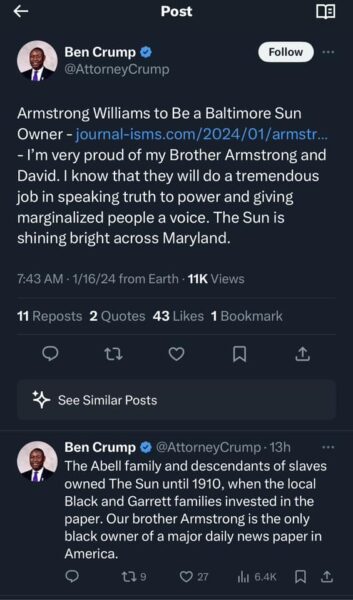
Baltimore Sun Sale Greeted With Hostility
“In a tense, three-hour meeting with staff Tuesday afternoon, new Baltimore Sun owner David Smith told employees he has only read the paper four times in the past few months, insulted the quality of their journalism and encouraged them to emulate a TV station owned by his broadcasting company,” Cody Boteler, Lee O. Sanderlin and Giacomo Bologna wrote Tuesday, updated Wednesday, for the Baltimore Banner.
It was only one of several articles reporting alarm at the decision by the Sun’s latest owner, investment firm Alden Global Capital, to sell the Sun to Smith, executive chairman of Sinclair Inc.
Conservative commentator and entrepreneur Armstrong Williams is a part-owner, but by and large mainstream media ignored his role, although one would be hard-pressed to name another African American with an ownership stake in a daily newspaper since the late Robert C. Maynard and his wife, Nancy Maynard, bought the Oakland Tribune in 1983, keeping it until 1992.
Williams had told Journal-isms that his role will be “whatever I want it to be.” He wrote on X Monday, “Subscribe to the Baltimore Sun for great Local News!“
The sale also prompted stories about the financial state of newspapers and their business models.
The Banner story continued, “Smith, whose acquisition of the paper from the investment firm Alden Global Capital was announced publicly Monday evening, told staff he had not read newspapers for decades, according to several people who attended the meeting but were not authorized to speak publicly.
“While the terms of The Sun sale are private, Smith told staff he paid ‘nine figures’ — meaning at least $100 million — for the paper, along with several community publications, including the Capital Gazette in Annapolis.
“That price would be a significant premium at a time when local newspapers are struggling to make a profit because of declining print advertising and circulation. In 2021, Maryland businessman Stewart Bainum had entered a nonbinding agreement to purchase The Sun for $65 million. That deal fell through and Bainum went on to launch The Baltimore Banner as a nonprofit.
“Smith, who is the executive chairman of Sinclair Inc., which operates more than 200 television stations nationwide, told New York Magazine in 2018 he considered print media ‘so left-wing as to be meaningless dribble.’ Asked Tuesday during the meeting whether he stood by those comments now that he owns one of the most storied titles in American journalism, Smith said yes. Asked if he felt that way about the contents of his newspaper, Smith said ‘in many ways, yes,’ according to people at the meeting.
“The Baltimore Sun won the 2020 Pulitzer Prize for local reporting. . . .”
Globally, 320 journalists were imprisoned on Dec. 1, the second highest number recorded since the Committee to Protect Journalists started gathering data on attacks on the press. The previous record was set in 2022. The top five jailers of journalists in 2023: China (44 journalists behind bars), Myanmar (43), Belarus (28), Russia (22), and Vietnam (19). Israel and Iran are next, tied at 17 each. (Credit: YouTube)
Israel Holding 31 Palestinian Journalists
“Israel has arrested a total of 38 Palestinian journalists since the start of its war with Hamas on 7 October and is currently holding 31, most of them without any charge, says Reporters Without Borders (RSF), condemning the use of detention to silence the Palestinian media and calling for the protection of all journalists and the release of those detained,” the press-freedom organization reported Jan. 9.
“Reporter Diaa al-Kahlout’s release on 9 January after more than a month in detention will not eclipse the scale of Israeli’s arbitrary imprisonment of Palestinian journalists. At least 31 of those arrested since 7 October – 29 in the West Bank, one in Gaza and one in East Jerusalem – are still held in Israeli jails, in most cases without being notified of any charge.
“This unprecedented wave of arrests and detentions, while the war continues in the Gaza Strip, has clearly been carried out with the deliberate aim of silencing the Palestinian media. All of the detained journalists work for Palestinian media outlets such as J-Media, Maan News Agency, Sanad and Radio al-Karama or are freelancers. . . .”
- Mary C. Curtis, Slate: Is Israel Committing Genocide? (podcast)
- Democracy Now!: Israel’s War on Journalists: More Reporters Killed in Gaza in 3 Months Than Any Country Over Entire Year
- Democracy Now!: How Israel Bombed Al Jazeera Journalists & Blocked Rescue of Cameraman Samer Abudaqa Until He Died
- Umar Farooq, Columbia Journalism Review: Remembering the ‘father figure’ of journalism in Gaza
- LZ Granderson, Los Angeles Times: When it comes to Gaza, the U.S. has decided whose suffering counts more
- Clare Malone, New Yorker: The Deadly Challenges of War Coverage in Gaza (Jan. 13)
- Palestine Chronicle: Israel Admits Assassination of Palestinian Journalist Wael Fannouneh in Gaza
- WAFA News Agency: U.S. conference demands immediate ceasefire and end to Israeli aggression on Gaza

Gary Fife, Indigenous Mentor, Role Model, Dies at 73
“When Gary Fife worked as an Anchorage radio and TV reporter in the 1990s, he stood out with his long, flowing dark hair, but his presence made history. He was the first to host ‘National Native News,’ a program that was launched in Alaska in the late 1980s,” Rhonda McBride wrote Thursday for KNBA, Alaska Public Media in Anchorage.
“Fife was still hosting radio shows and writing a weekly column when he died Sunday in Oklahoma at the age of 73, after he was hospitalized for respiratory problems.
“He devoted the last years of his life to his tribe’s online news publication, MvskokeMedia, capping off more than a half century of efforts to change the way journalists cover Indigenous peoples.
“Across Oklahoma, Gary Fife was known as the Voice of Mvskoke, a voice familiar to Indian Country, in large part due to his work on National Native News.
“Back then, Diane Kaplan ran the Alaska Public Radio Network. She said when Native leaders first approached her about producing a national show from Alaska, it sounded like a good idea. New satellite technology made it very doable, but financial support was a huge barrier to overcome.”
She recruited Fife, “who believed the media was a modern extension of traditional storytelling and could be used to uplift what was then an invisible minority. . . .
“Kaplan says Fife brought what was, at the time, a rare combination of skills – a Native American who not only had experience in reporting and broadcasting but also a deep knowledge of Native history, politics and the issues of the day, as well as lots of contacts around the nation.
“Thirty years ago in Atlanta, Fife was in the spotlight at a national minority journalism conference, moderated by ABC’s Carole Simpson, one of the first Black women to anchor a network newscast. It was there that Fife challenged journalists to do a better job of covering Indian Country and confronted them about how they perpetuate stereotypes.
“ ‘One of my pet peeves used to be — is — that every new story we ever saw or heard opened up with a flute,’ Fife told the 1994 gathering. ‘A lot of tribes don’t even use flutes, for God’s sake. I mean, would you use a polka every time you did a story on a German?’ . . .”
The Indigenous Journalists Association added, “In September 2015, Fife was the first to stand and advocate publicly for the Muscogee Nation’s first free press law during a Muscogee Nation National Council committee meeting where the bill was introduced. . . . Throughout the Muscogee Nation’s long free press fight for what would eventually become a constitutional amendment ratified by tribal citizens in September 2021, Fife stood as an example for and gave advice to those who continued to lead the cause.
“Before free press was even on the map, Fife risked asking tough questions of tribal officials with no legal protection for his job, serving as an example and setting the bar for other Mvskoke Media employees. He reminded them that the citizens are the real bosses. In 2023 Fife was named as one of the Living Legends of the Muscogee (Creek) Nation. . . .”
- Joaqlin Estus, Indian Country Today: Native journalism pioneer: Gary Fife still going strong (Oct. 4, 2021)
- Braden Harper, Mvskoke Media: Native American radio pioneer honored as a Muscogee Living Legend (June 30, 2023)
- Indigenous Journalists Association: IJA mourns the loss of Gary Fife, mentor to many Indigenous journalists
Short Takes
-
 “Robert Samuels (pictured), one of his generation’s most perceptive, empathetic and eternally curious journalists, is returning to The Washington Post as a National enterprise reporter with a broad mandate to document America at this consequential time,” the Post announced Thursday. Samuels, co-author with Toluse Olorunnippa of the Pulitzer Prize-winning “His Name Is George Floyd,” joined the New Yorker last March. “Basically, I missed having brainstorming meetings and I missed working with my friends,” Samuels messaged Journal-isms. “There was so much that I liked about the New Yorker, but, at this point in my life, I found the lonely silence of a one-person office to be overwhelming. With so much going on in the world, I did not feel like now was the time for the existentialism that kind of isolation brings me. My head needs to be immersed in telling great and ambitious stories and I have more confidence that I’ll be able to execute them with the community at the Post.”
“Robert Samuels (pictured), one of his generation’s most perceptive, empathetic and eternally curious journalists, is returning to The Washington Post as a National enterprise reporter with a broad mandate to document America at this consequential time,” the Post announced Thursday. Samuels, co-author with Toluse Olorunnippa of the Pulitzer Prize-winning “His Name Is George Floyd,” joined the New Yorker last March. “Basically, I missed having brainstorming meetings and I missed working with my friends,” Samuels messaged Journal-isms. “There was so much that I liked about the New Yorker, but, at this point in my life, I found the lonely silence of a one-person office to be overwhelming. With so much going on in the world, I did not feel like now was the time for the existentialism that kind of isolation brings me. My head needs to be immersed in telling great and ambitious stories and I have more confidence that I’ll be able to execute them with the community at the Post.”
- “A billionaire couple is giving $100 million to Atlanta’s Spelman College, which the women’s school says is the largest-ever single donation to a historically Black college or university,” Jeff Amy reported Friday for the Associated Press. “The donation was announced Thursday by Ronda Stryker and her husband William Johnston. She is the billionaire granddaughter of the founder of medical device maker Stryker Corp. and he is the chairman of money management firm Greenleaf Trust. They live in Michigan. Spelman said that it would use $75 million to endow scholarships.” Spelman does not offer a journalism program, but says of its English majors, “Even in the wake of the 2008 economic downturn, our majors have gone on to top graduate and professional schools, and have built successful careers in areas such as arts administration, communications, politics, journalism, public health, technology, business, law and education.”
- “Tiffany Cross, Angela Rye and Andrew Gillum teamed up on a new podcast, ‘Native Land Pod,’ and they’re spilling all of the tea,” Jessica Washington wrote Thursday for The Root. “During a ‘testimony’ segment on the latest episode of the show, Cross shared the story of her split from MSNBC — and she didn’t hold anything back. ‘I was never given an official reason for why they canceled my show,‘ said the former host of ‘The Cross Connection,’ ‘but it was pretty obvious that I had drawn the ire of white conservatives.’ . . .”
- “TelevisaUnivision has cut hundreds of jobs across Univision network over the course of Tuesday and Wednesday this week and cancelled its long-running sports show ‘República Deportiva,‘ which had been on the air almost 25 years,” Veronica Villafañe reported Thursday for her Media Moves site. “El Nuevo Herald reports Univision executed about 200 layoffs. According to inside sources, high-profile talent was laid off from news and sports at the local and network level. Among them, Univision 23 news anchor Sandra Peebles, who had worked at the station since 1999, and Félix Fernández, co-host of ‘República Deportiva.’
- “The number of Black people living in the United States reached a new high of 47.9 million in 2022, up about a third (32%) since 2000, according to a Pew Research Center analysis of government data. This group is diverse, with a growing number and share born outside the U.S. and an increasing number saying they are of two or more races,” Mark Hugo Lopez and Mohamad Moslimani reported Thursday for the Pew Research Center. Ahead of Black History Month, Pew has updated its U.S. Black Population fact sheet and released a new “Key Facts about Black Americans” analysis with the latest available census data.
- “American men are stuck in what’s been dubbed a friendship recession, with 20 percent of single men now saying they don’t have any close friends. More than half of all men report feeling unsatisfied with the size of their friend groups,” Geoff Bennett reported from Phoenix Wednesday for the “PBS NewsHour.” Bennett spoke to founders of Professional Black Men’s Friends Group and other such responses to the phenomenon. Similarly, Jean Guerrero wrote a column on the subject for the Los Angeles Times.

- “More than two dozen Black civil rights leaders in the Southeast have been high-value targets in power companies’ battle for market dominance, courted and at times even co-opted by the industry, according to an investigation by Floodlight and Capital B, “Mario Alejandro Ariza, Kristi E. Swartz, Adam Mahoney reported Jan. 9 for the news organizations. “The multibillion-dollar power companies use Black support to divert attention from the environmental harms that spew from their fossil fuel plants, the investigation found, harms which disproportionately fall on Black communities.”
- . . . On addition, “A Floodlight investigation found Alabama Power runs a news service and its foundation bought a Black newspaper. Neither publishes critical stories about the utility,” Miranda Green reported Wednesday for Floodlight. “The Birmingham Times executive editor, Barnett Wright, said the outlet’s coverage is limited due to its small staff and having to make hard editorial decisions on what to cover. ‘The Alabama Power Foundation had or has zero influence in the newsroom,’ Wright said in an email. ‘As the executive editor, I have never had any conversation with the Alabama Power Foundation about any article the Birmingham Times chooses to run or not run.’ ”
- Following up on historic legislation in California in 2021 that provided financial reparations to people who were forcibly or involuntarily sterilized, “a year-long investigation by UC Berkeley’s Investigative Reporting Program and KQED found that the compensation board has denied a majority of applicants,” graduate student Cayla Mihalovich reported Nov. 1. “The investigation included 30 public records requests, the review of more than 3,000 pages of documents — and interviews with survivors, advocates, medical experts and lawmakers. Among the applicants who volunteered their demographic information, the majority self-identified as Black or African American. Approximately 47% self-identified as male, 40% female and 4% transgender.”
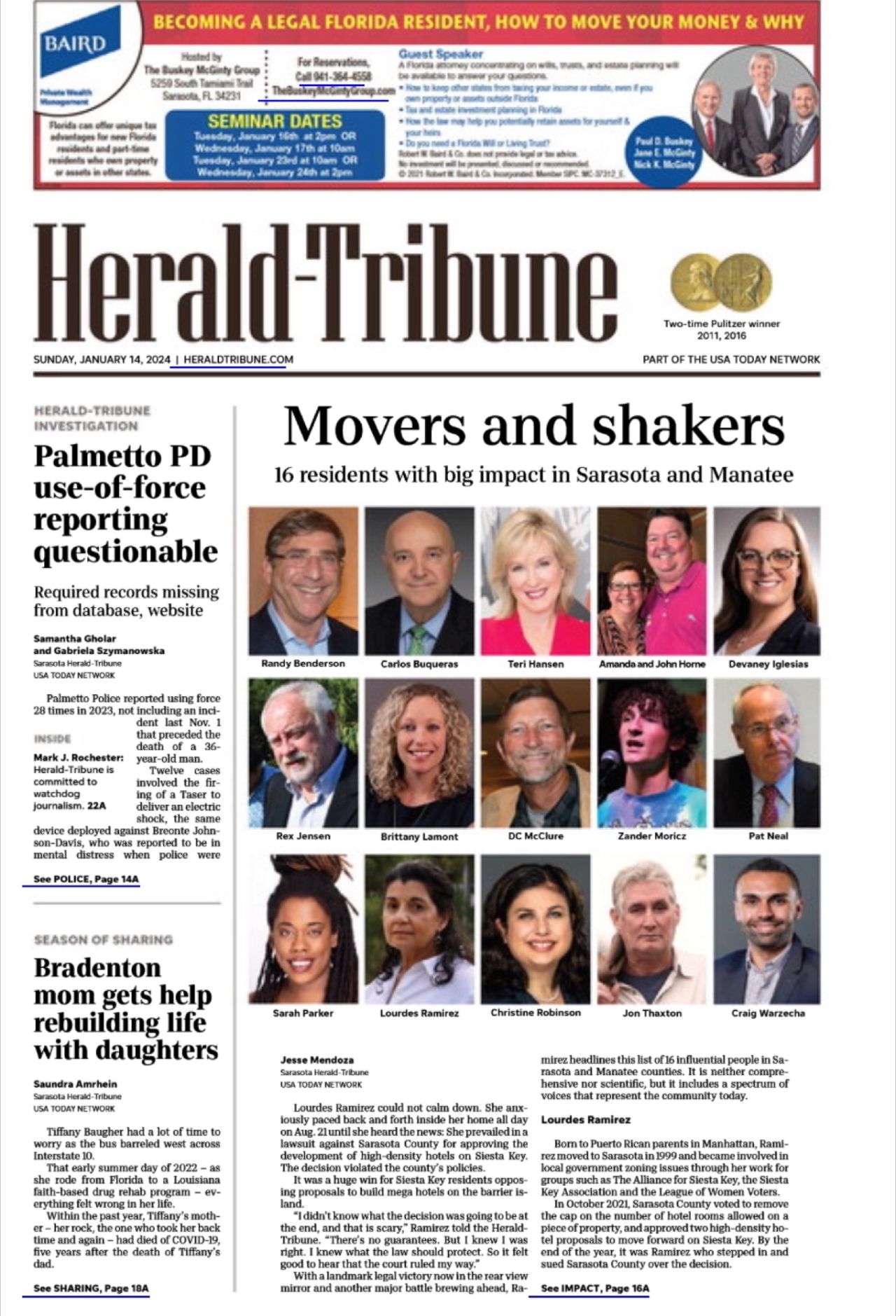 “Only 10 days into my tenure as Executive Editor at the #SarasotaHeraldTribune [in Florida] and we’ve published our first investigative piece detailing how a local police department has failed to publish required use of force reports about its officer’s use of their service weapons, Mark J. Rochester wrote Jan. 14 on social media. “The department hadn’t disclosed the required data in two years, until a Herald-Tribune investigation following the death of a local man in November.”
“Only 10 days into my tenure as Executive Editor at the #SarasotaHeraldTribune [in Florida] and we’ve published our first investigative piece detailing how a local police department has failed to publish required use of force reports about its officer’s use of their service weapons, Mark J. Rochester wrote Jan. 14 on social media. “The department hadn’t disclosed the required data in two years, until a Herald-Tribune investigation following the death of a local man in November.”
- “Police across America killed a record 1,329 people in 2023, and Black people were nearly three times more likely to be slain than whites, according to the Mapping Police Violence project,” theGrio reported Thursday. “It’s the most deaths at the hands of police since the project began collecting data in 2013, when 1,079 people were killed, a chart on its website shows. . . .”
- “Gracenote, Nielsen’s content metadata unit said it added a Diversity Spotlight feature to its Studio System that will make diverse content creators and talent more discoverable and accessible,” Jon Lafayette reported Friday for Broadcasting & Cable. “Gracenote worked with the advocacy groups IllumiNative, Gold House, RespectAbility, National Hispanic Media Coalition (NHMC) and Coalition of Asian Pacifics in Entertainment (CAPE) to develop the system to meet diversity criteria and open new casting, funding and collaboration opportunities.”
- “Morgan State University’s School of Global Journalism and Communication (SGJC) is partnering with famed filmmaker Spike Lee’s 40 Acres & A Mule Filmworks and The Gersh Agency, a leading entertainment industry talent firm, to create an extensive multimedia summer internship program,” the university announced Wednesday. “The internship program’s goal is to prepare the SGJC student to be hired with a full-time position within the film industry upon graduation. . . .”
 Karine Jean-Pierre, the White House press secretary, in November named a new lectern in the White House briefing room for Alice Dunnigan (pictured) of The Associated Negro Press, the first Black woman to be credentialed to join the White House press corps, and Ethel L. Payne, who joined her on the beat a few years later for The Chicago Defender, Erica L. Green reported Sunday for The New York Times. Sonya Ross, former White House correspondent for the Associated Press, wrote on LinkedIn, “As those of us who’ve done the beat can attest, being a Black woman in the White House press corps can be a study in being invisible most of the time. To know that, from now on, Black women White House reporters will have this tangible, everyday reminder of our worth as political journalists in the Briefing Room is a really, really good feeling. My heart is full.”
Karine Jean-Pierre, the White House press secretary, in November named a new lectern in the White House briefing room for Alice Dunnigan (pictured) of The Associated Negro Press, the first Black woman to be credentialed to join the White House press corps, and Ethel L. Payne, who joined her on the beat a few years later for The Chicago Defender, Erica L. Green reported Sunday for The New York Times. Sonya Ross, former White House correspondent for the Associated Press, wrote on LinkedIn, “As those of us who’ve done the beat can attest, being a Black woman in the White House press corps can be a study in being invisible most of the time. To know that, from now on, Black women White House reporters will have this tangible, everyday reminder of our worth as political journalists in the Briefing Room is a really, really good feeling. My heart is full.”
- “MSNBC’s new weekend lineup debuts to MSNBC’s most-watched weekend in 12 weeks with viewership up +8% compared to the 4th quarter average,” an MSNBC spokesperson messaged. “MSNBC’s premiere of ‘The Weekend,’ co-hosted by Symone Sanders, Alicia Menendez and Michael Steele on Saturday, Jan. 13, topped every CNN program in total viewers that day. . . .”
 In Kansas City, Mo., KCTV-TV announced the launch of “Cinco con Carolina,” “a fresh Spanish news segment designed to strengthen our connection with the vibrant Hispanic community in the metro.” Spearheaded by local fluent Spanish-speaking news anchor Carolina Cruz (pictured), the five-minute daily news update will broadcast on KCTV5′s website, social media and streaming platforms Monday-Friday at 11:05 a.m.
In Kansas City, Mo., KCTV-TV announced the launch of “Cinco con Carolina,” “a fresh Spanish news segment designed to strengthen our connection with the vibrant Hispanic community in the metro.” Spearheaded by local fluent Spanish-speaking news anchor Carolina Cruz (pictured), the five-minute daily news update will broadcast on KCTV5′s website, social media and streaming platforms Monday-Friday at 11:05 a.m.
- Supporting congressional efforts to make AM radio mandatory in vehicles, the National Association of Broadcasters released a seven-page report [PDF] citing AM radio’s value in emergencies, adding that “Of the nearly 4,500 AM stations across the U.S., 16%, approximately 735, serve niche or minority audiences, often delivering content in languages other than English. Of the 1,500 minority-owned stations, approximately 600 stations broadcast, at least in part, in languages other than English.” The NAB also said “Nearly 440 of these stations feature Spanish language or Latino/regional formats, fostering connections and cultural expression for Spanish-speaking communities.”
- The Cleveland Museum of Art is shrouding three display cases containing Native American artifacts while keeping images of those artifacts visible online, Chris Quinn, editor of cleveland.com/The Plain Dealer, explained in a “letter from the editor” Saturday. “The museum shrouded the displays because of a 1990 federal law adopted by Congress, the Native American Graves Protection and Repatriation Act. The law was just updated to require museums to get consent of descendants, tribes or Native Hawaiian Organizations before exhibiting funerary and sacred objects or human remains. The new rules started Jan. 12.” Quinn said he was ready to publish photos of the artifacts online, but was dissuaded by art critic Steve Litt and his editor, Leila Atassi.” When you’ve got smart, thoughtful people on your team, you really should give weight to their positions. Also, I opted not to use them to spare Steve some bile.”
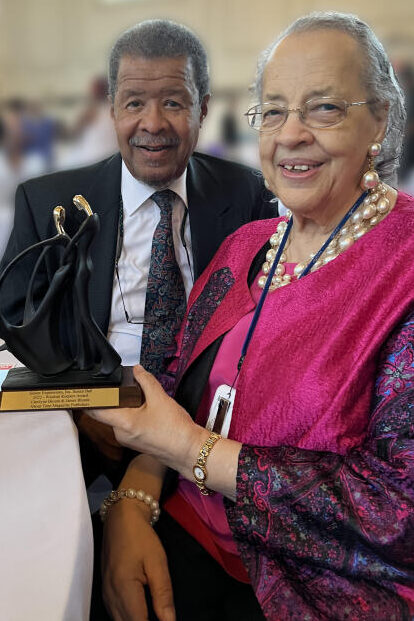 Carolyne Blount, who with her husband, James Blount (pictured), founded about . . . time, a Rochester, N.Y., magazine focused on the African American community, died Jan. 11 of congestive heart failure in a Monroe County, N.Y., hospice, their son, James, told Journal-isms. She was 80. In 1972, the Blounts took over about .. . time, and Mrs. Blount led the publication as its executive editor and co-publisher for more than 50 years. Her husband died in September. A memorial service/celebration of life is planned for April 13 in Rochester. The Rochester Association of Black Journalists called her “Our Friend, Mentor, And Colleague.” James Blount said that the Blounts would be “making a family decision” on who would run the magazine.
Carolyne Blount, who with her husband, James Blount (pictured), founded about . . . time, a Rochester, N.Y., magazine focused on the African American community, died Jan. 11 of congestive heart failure in a Monroe County, N.Y., hospice, their son, James, told Journal-isms. She was 80. In 1972, the Blounts took over about .. . time, and Mrs. Blount led the publication as its executive editor and co-publisher for more than 50 years. Her husband died in September. A memorial service/celebration of life is planned for April 13 in Rochester. The Rochester Association of Black Journalists called her “Our Friend, Mentor, And Colleague.” James Blount said that the Blounts would be “making a family decision” on who would run the magazine.
- “A national oral history project aims to document the experiences of Indigenous children who attended federal boarding schools. The Department of the Interior announced the project in September as part of the Federal Indian Boarding School Initiative,” Ellie Willard reported Jan. 8 for Cronkite News, produced by the Walter Cronkite School of Journalism and Mass Communication at Arizona State University. “The National Native American Boarding School Healing Coalition (NABS) has been entrusted to lead the project with $3.7 million in grant funding through the Bureau of Indian Affairs and the National Endowment for the Humanities. . . .”
- “
 A year after the gruesome murder of journalist Martinez Zogo (pictured), authorities in Cameroon are yet to fully shed light on the circumstances surrounding his kidnapping, torture, and killing or hold any suspects to account,” the International Press Institute said Wednesday. Zogo was kidnapped on January 17, 2023, in Yaoundé, and his body was found four days later, on January 21. . . .”
A year after the gruesome murder of journalist Martinez Zogo (pictured), authorities in Cameroon are yet to fully shed light on the circumstances surrounding his kidnapping, torture, and killing or hold any suspects to account,” the International Press Institute said Wednesday. Zogo was kidnapped on January 17, 2023, in Yaoundé, and his body was found four days later, on January 21. . . .”
- In Somalia, “Two media rights watchdogs say they documented at least eight incidents last year where journalists were killed, or injured, arrested, threatened and intimidated and their equipment confiscated,” Mukhtar Mohamed Atosh and Harun Maruf reported Thursday for the Voice of America. “According to the Federation of Somali Journalists and Somali Media Association, multiple journalists were arrested, some were mistreated, while two died, one of whom succumbed to injuries sustained from a car bomb five years earlier. The other died in an explosion from a person-borne device late last year, the two watchdogs said.” The story was headlined, “Somalia’s Frontline Women Journalists Face Multiple Risks.”
- “Reporters Without Borders (RSF), the Paris-based organisation that defends the right of every human being to have free and reliable information, said that it was very disappointing to see Grenada’s government bar reporters from covering its Cabinet swearing-in ceremony last week,” Linda Straker reported Jan. 9 for nowgrenada.com. “RSF was disappointed to see Grenada’s government bar reporters from covering its cabinet swearing-in ceremony last week. As the new Cabinet takes power, it is essential for Grenada’s government to signal its commitment to press freedom and transparency going forward,” said a statement on the RSF USA X (formerly Twitter) account.”
- “A Burundi journalist is appealing her 10-year prison term at the country’s Supreme Court,” the Voice of America reported Tuesday. “Floriane Irangabiye, who was convicted of undermining the integrity of Burundi’s national territory, has been detained since August 2022. . . . The case against Irangabiye is connected to her work as a commentator and host at Radio Igicaniro, a diaspora-based online outlet that is often critical of the government. . . . Local and international press freedom groups have echoed those calls for Irangabiye’s release.”
To subscribe at no cost, please send an email to journal-isms+subscribe@groups.io and say who you are.
Facebook users: “Like” “Richard Prince’s Journal-isms” on Facebook.
Follow Richard Prince on Twitter @princeeditor
Richard Prince’s Journal-isms originates from Washington. It began in print before most of us knew what the internet was, and it would like to be referred to as a “column.” Any views expressed in the column are those of the person or organization quoted and not those of any other entity. Send tips, comments and concerns to Richard Prince at journal-isms+owner@
View previous columns (after Feb. 13, 2016).
View previous columns (before Feb. 13, 2016)
- Diversity’s Greatest Hits, 2018 (Jan. 4, 2019)
- Book Notes: Is Taking a Knee Really All That? (Dec. 20, 2018)
- Book Notes: Challenging ’45’ and Proudly Telling the Story (Dec. 18, 2018)
- Book Notes: Get Down With the Legends! (Dec. 11, 2018)
- Journalist Richard Prince w/Joe Madison (Sirius XM, April 18, 2018) (podcast)
- Richard Prince (journalist) (Wikipedia entry)
- February 2018 Podcast: Richard “Dick” Prince on the need for newsroom diversity (Gabriel Greschler, Student Press Law Center, Feb. 26, 2018)
- Diversity’s Greatest Hits, 2017 — Where Will They Take Us in the Year Ahead?
- Book Notes: Best Sellers, Uncovered Treasures, Overlooked History (Dec. 19, 2017)
- An advocate for diversity in the media is still pressing for representation, (Courtland Milloy, Washington Post, Nov. 28, 2017)
- Morgan Global Journalism Review: Journal-isms Journeys On (Aug. 31, 2017)
- Diversity’s Greatest Hits, 2016
- Book Notes: 16 Writers Dish About ‘Chelle,’ the First Lady
- Book Notes: From Coretta to Barack, and in Search of the Godfather
- Journal-isms’ Richard Prince Wants Your Ideas (FishbowlDC, Feb. 26, 2016)
- “JOURNAL-ISMS” IS LATEST TO BEAR BRUNT OF INDUSTRY’S ECONOMIC WOES (Feb. 19, 2016)
- Richard Prince with Charlayne Hunter-Gault, “PBS NewsHour,” “What stagnant diversity means for America’s newsrooms” (Dec. 15, 2015)
- Book Notes: Journalists Follow Their Passions
- Book Notes: Journalists Who Rocked Their World
- Book Notes: Hands Up! Read This!
- Book Notes: New Cosby Bio Looks Like a Best-Seller
- Journo-diversity advocate turns attention to Ezra Klein project (Erik Wemple, Washington Post, March 5, 2014)

